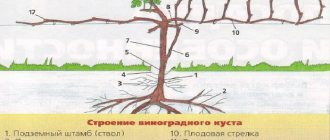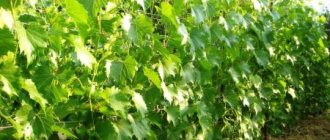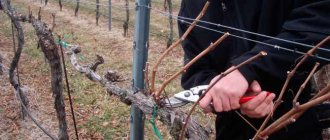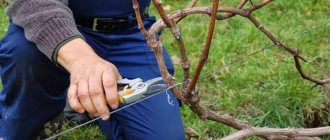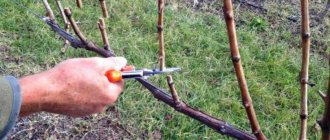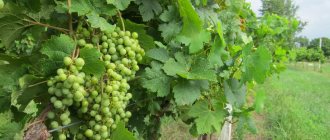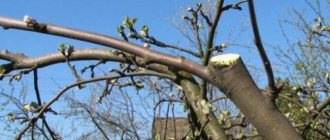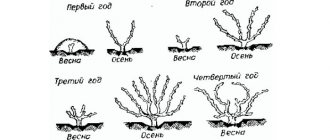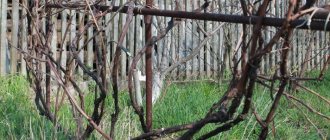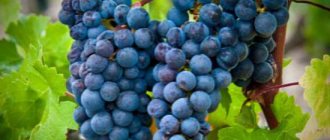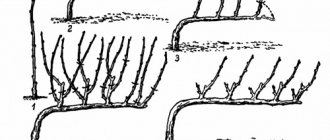What is grape pruning for?
Pruning grapes is a necessary technique for caring for the plant. The grapes bear fruit only on the current year's shoots, developing from the eyes located on last year's vines. In rare cases, in some varieties, small yields are produced by shoots that grow from dormant buds on perennial wood. Therefore, a one-year-old vine located on two-year-old wood is left for fruiting.
Pruning is carried out annually on all bushes, regardless of their age. The essence of pruning is to remove or shorten individual shoots and older parts of the crown of bushes. Without pruning or with little pruning, the bushes take on a wild appearance and bear fruit irregularly. At the same time, you get a lot of bunches, but they are all small, with small and low-quality berries.
The goals and objectives of pruning are different depending on the age of the bush. When pruning young bushes, its task comes down to creating the shape of the bush with the formation of its skeletal, permanent part - the trunk or trunk and its main branches in the form of sleeves, shoulders, bearing horns, knots and fruit links. Pruning young bushes is nothing more than shaping the grapes. When pruning adult bushes, the vines are left for next year's harvest, the selected shape of the bush is maintained, and the aged parts of the crown are periodically renewed.
It should be remembered that any pruning weakens the bush. Excessive pruning of young plants inhibits growth and delays the onset of fruiting. In the absence or extremely weak pruning, it is impossible to obtain a high-quality grape harvest. The fewer shoots left on the bush, the stronger the growth of each individual shoot. However, the vigor of the entire bush and its ability to bear fruit decrease with a decrease in the number of shoots.
Pruning and shaping of bushes is easier and more straightforward to carry out on supports or trellises for grapes.
When to prune?
Experienced specialist gardeners recommend pruning grape bushes in the autumn. This justifies a number of reasons:
- In autumn, the growth processes of the bushes stop and the plant falls asleep. This means that growth promoting substances will not be used up.
- Spring is the time of awakening and spring “crying” of the bush. By pruning a bush, you deprive it of the liquid accumulated in the stems.
- At the time of spring pruning, you risk disturbing the young shoots.
When to prune grapes
Pruning is carried out during the dormant period of the grapevine. In the southern regions, where bushes are not damaged by winter frosts, they are pruned in the fall after leaf fall, in winter and spring before sap flow begins; in areas of covered viticulture - in the fall, before covering the grapes for the winter (preliminarily), and in the spring after they are opened (finally), i.e. in two stages.
Autumn pruning is carried out after the leaves fall or die from the first autumn frosts. In places where frosts come early, you should not wait for leaves to fall. If the time has come for covering the bushes and there is a threat of frost, the vine can be covered with leaves. At the same time, all obviously unnecessary parts are removed - the immature vine and its parts, underdeveloped shoots, stepsons and tendrils, and the fruit-bearing vine is shortened so that a large supply of eyes remains.
In the spring, after the bushes have opened and the results of their overwintering have been revealed, final pruning is carried out: broken, frost-damaged or dried out vines are removed or shortened, shoots left for knot replacement and restoration, lowering sleeves or rejuvenating old parts of the crown are shortened.
Autumn and winter pruning promotes earlier blooming of the eyes, and late spring pruning leads to a slight delay in the onset of growth. Therefore, in places where spring frosts end at a later date, it is advisable to prune closer to the moment the eyes open.
It is better to prune young grape bushes in all areas in the spring.
Features in regions
The timing of pruning in regions differs significantly, so it is important to understand when to prune grapes correctly in the Moscow region, Kuban and in the middle zone.
Moscow region
In the Moscow region, spring formation of bushes should begin only in the second year after planting. In the first year, the vine is only tied up, and only in cases where it falls to the ground. Pruning is carried out in two stages:
- In autumn - cut off 2/3 of the planned volume.
- In spring - remove weak, damaged and excess shoots in accordance with the chosen scheme.
More details about the formation by year in a separate article.
One of the most successful formation options in this case is the Guyot scheme:
- In the autumn of the first year, the shoot is cut down to 2 buds.
- In the second year, 2 annual vines grow, they are also pruned: the first is left long;
- the second is shortened to 2-3 ocelli.
In the third year, the bushes are ready to bear fruit and need a garter. During the procedure, dry annual shoots are placed horizontally, and green shoots grown on them are placed vertically.
Kuban
When to prune in Kuban? For the Krasnodar Territory, any type of pruning is acceptable. In Kuban, it is recommended to carry out sanitary pruning in the fall, and this does not have to be done 2 weeks after the leaves fall - some gardeners leave it until late autumn or even winter.
In what month can you prune in the spring? It is preferable to start forming a bush in March before the onset of sap flow. Spring pruning in Kuban should begin when the buds have not yet blossomed. You can learn about the formation of a bush in a separate article.
Middle lane
When to prune in the middle zone? Grapes in central Russia often suffer from damage from cold weather, so only frost-resistant varieties should be grown here. In this case, the plants must be covered for the winter. The first three years, while the bushes are young, they can only be pruned in the spring. Then, in the middle zone, it is better to switch to a two-stage autumn-spring formation and perform heavy pruning to speed up the ripening process of the berries.
Reference! To determine the timing of pruning in the middle zone, they are usually guided by air temperature - this procedure is carried out when it exceeds +5 degrees Celsius.
What is a substitution knot
Knot replacement is part of the old European pruning system, discovered and popularized by French scientist and winegrower Jules Guyot in the mid-19th century. This pruning system is almost never found anywhere, but its essence is that just below the fruit shoot a branch is also left on which replacement shoots will grow.
In autumn, the entire fruit part is cut off to the knot. And the two vines of the twig again turn into an arrow and a twig.
The purpose of a knot replacement is to guarantee strong and well-ripened vines for fruiting and replacement next year.
Disadvantage: at least two extra idle shoots.
What does autumn pruning give?
Experienced winegrowers know that grapes can be pruned in the spring and even in the summer, but most carry out such work in the fall. This attitude is not accidental; with the help of autumn pruning you can achieve the following results:
- Reduce the impact of polarity on yield.
- Correctly form fruit links.
- Prepare grapes for winter shelter.
- Increase the volume of the grape bunch.
- Get the harvest a little earlier than your neighbor.
- Improve the taste of berries.
- Help the plant fight diseases.
Properly pruned grapes are much easier to care for and harvest. But pruning must be done every year without starting the plant. Otherwise, you can negate all previously achieved results and become disillusioned with viticulture.
With the help of proper pruning you can regulate fruiting.
Fruit link with replacement knot
The fruiting link should be formed so that the replacement knot is always on the sleeve below the fruiting frog. This is the basic rule of pruning, resulting from the biological characteristics of the grapevine. With this formation of the fruit link, the location of wounds during pruning is regulated, the possibility of overcuts is eliminated and the process of pruning bushes is facilitated.
No more than three well-developed shoots should be grown on a branch. In this case, it is very important that the lower shoot is on the outside, and the top shoot is on the inside. This placement of shoots on twigs leads to one-sided wounds on the inside of the sleeve, shoulder and other perennial parts of the bush. This is achieved when a lower, normally developed eye on the outer side is left on the knot when pruning. If the lower eye is on the inside of the knot, it is removed and the shoot is cut one eye higher.
During annual pruning in the fruit link, the fruit-bearing arrow along with the shoots is removed, and a new link is created from the shoots that developed on the replacement knot. In this case, the lower shoot of the knot, which occupies an external position, is cut short into a knot with two or three eyes, and the upper one - into a fruit shoot.
Trimming schemes
In addition to the fan-shaped, standard-free multi-arm pattern discussed above, there are many others. One of the simplest is the simple one - according to the Guyot method:
- 1 year - 2 eyes are left on the shoot;
- spring 2 years - the resulting 2 shoots are cut: one for the fruiting vine, the second for a short replacement branch (see figure);
- autumn 2 years - a new future fruit link grows on a branch from the eyes;
- spring 3 years - the vine is strengthened to the trellis horizontally, and the emerging shoots - vertically;
- autumn 3 years - the fruiting vine is removed, a new fruiting link is formed from the knot and this is repeated every year.
Another forming method is cordon. Such bushes have 1-2 or more vertical trunks, each with 1-2 sleeves with 1-2 fruit links. The sleeves can be placed on the trellis either horizontally or obliquely. There are both single-tier and two-tier cordon formations, single- and double-sided. Uncovered industrial vineyards in Russia are often grown using the Cazenave cordon (see figure)
What to do if there are no shoots on the replacement knot or they are weak
In practice, there are often cases when on replacement knots, for various reasons, only one shoot developed or did not develop at all.
If there is not a single shoot on the replacement branch, it is removed and the fruit shoot is left. On it, the lower shoot from the outside is cut short to a knot, and one of the next shoots, the most developed, is shortened to the fruit shoot. All other shoots on last year's arrow are removed.
In the case when only one shoot has developed on a branch, depending on its placement, it is cut either short to the branch or long to the fruit shoot. If the shoot occupies an external position, it is cut short to a replacement branch, and to form an arrow, the best developed shoot on the fruit-bearing arrow is used.
When only one upper shoot develops on a branch from the inner eye, it is cut long, and only one reserve, well-developed shoot is left on last year’s shoot. The shoot on the knot is tied with a bend, leaving two eyes under the bend, of which the lower one should occupy the outer position. Behind the bend, on the horizontal part of the tied shoot, four to eight well-developed ocelli are left. With such pruning and gartering, the fruit link is restored again within a year. The reserve shoot left behind is sometimes used as an additional fruit shoot.
Pruning grapes with reinforced fruit link and knot replacement
If it is necessary to increase the load of the bush with eyes, two fruit shoots are left in the fruit link above the replacement knot. In this case, the lower fruit arrow should be shorter by two or three eyes of the upper fruit arrow. On the vines left during pruning, the shoots and tendrils are removed.
Grape polarity (formation)
Forming grapes involves pruning the stems according to the diagram. The easiest and most popular is the fan polarity of the grapes. It is convenient both for covering and for ripening berries.
Let's consider the scheme of this formation for beginner gardeners:
- During the first season, the main task is to grow a strong stem. For the winter, he bends down, insulates and covers himself. One-year grapes are not pruned.
- Pruning two-year-old grapes involves leaving 2 buds on the shoots. We cut off the remaining parts and leave them for 3 years.
- During the third season, shoots grow from the left buds. When pruning in autumn, we leave the strongest shoots from the grown shoots. We bend them to the ground, insulate them and cover them.
- In the spring we remove these shoots, leaving 2 buds. And already in the fall we get 4 strong sleeves.
- We unbend the sleeves and fix them in different directions. When trimming, it should turn out that the inner sleeves will be shorter than the outer ones, but not less than 50 centimeters.
- At 4 and 5 years we continue the formation of fruit links.
- In autumn, we cut off the lower woody trunks of a five-year-old plant, leaving 2 buds. This will make a substitution knot. At the top woody trunks we leave 4 eyes for the formation of fruit shoots. If you strictly follow this scheme, you will definitely get a high-quality and prolific shrub.
Pruning grapes without knot replacement
You can also prune grapes without using a replacement knot. For beginning winegrowers, it can be very difficult to understand the fruit link with a substitution knot, this is normal, everything comes with experience, but do not fall into despair, a substitution knot is not at all necessary, the grapes are perfectly formed, pruned and bear fruit perfectly even without a substitution knot.
Abandoning a replacement knot is also forced by the catastrophic lack of extra space on the site, when the bushes are planted tightly and the space on the trellis is extremely limited; in this case, the shoots on the replacement knot steal space from the fruit shoots, and many are forced to abandon the replacement knots.
The essence of the method is very simple, we do everything the same, just forget about the replacement knots, and select the fruit shoot from the fruit-bearing shoots. The fruiting shoot for next year should be located as close as possible to the head of the bush.
When cutting knotless replacements, we also remember that the wounds should be located on one side of the sleeve.
This method also has disadvantages, as the sleeve lengthens much faster and it is necessary to periodically replace it, forming a new sleeve from a shoot growing from the head of the bush.
Pruning tips from a professional winegrower
How to prune grapes correctly
How to prune grapes for the winter? If you strictly follow all the recommendations of experienced vineyards, then the procedure for pruning the grapevine will be quite simple and will not take much time. However, sometimes beginners make serious mistakes, which subsequently have a negative impact on the quantity, quality and health of the vineyard. If this is your first time encountering the procedure of pruning grapes, then it is advisable to watch several video lessons on the Internet before something irreparable happens.
The skill of pruning grapevines is a very important skill, without which it is impossible to grow a large vineyard. If you master this skill, you will be able to grow young bushes and harvest the maximum harvest from mature plants, which will give you large, juicy berries. In addition, the vine will be a wonderful decoration for the facade of a house, gazebo or fence.
So, you have learned how to prune a vineyard as correctly as possible. Remember that proper pruning is a guarantee of a bountiful harvest and prosperity for your vineyard! To conclude the topic “pruning grapes in the fall for beginners,” we offer the following video, which will tell you about the methods and basic rules for pruning grapes:
Reinforced fruit link without knot replacement
It is also possible to prune grapes with a strengthened fruit link without leaving a replacement knot. Using a reinforced fruit link, when breaking green shoots in the spring, try to leave approximately the same number of fruit-bearing shoots on each fruit shoot.
Pruning of a reinforced fruit link without knot replacement.
Bush rejuvenation
Over the years, the perennial parts of the crown of the bush - sleeves, shoulders, trunks and horns - lengthen, become covered with a large number of wounds and age. All this leads to weakening of shoot growth and fruiting of the bush and even the death of individual parts. At the base and on perennial wood, especially near wounds, dormant buds and shoots begin to intensively develop. Such bushes must be completely replaced or the outdated part of the crown must be rejuvenated.
To rejuvenate the sleeve, trunk and other perennial parts of the crown of the bush, when green shoots are broken off, one shoot is left, located closer to the base of the part to be rejuvenated. As the shoot grows, it is tied vertically to promote good development and ripening. In the second year, the shoots are cut to a restoration branch (stand), and only the best shoots are left on the sleeve for fruiting.
The outdated sleeve is removed no earlier than the second year of life of the restored knot, when its thickness becomes at least half the thickness of the rejuvenated part of the trunk or sleeve. When removing the part to be replaced, a stump of 2-3 cm is left above the knot, cleaning its upper cut with a garden knife. In order not to weaken the bush by causing large wounds, it is advisable to rejuvenate the sleeves gradually - no more than once a year.
Pruning technique
For pruning, use well-sharpened pruning shears, a hacksaw file and a garden knife. The cuts should be made so that the wounds caused during pruning are placed on one, preferably the inner side of the perennial parts. Opposite wounds (cuts) are especially dangerous, since dead tissue on both sides interferes with the movement of nutrients and water in the plant. The cut is made perpendicular to the axis of the shoot, in this case the wound will be small. Straight cuts should also be used when removing fruit-bearing vines, excess sleeves and other obsolete perennial parts of the bush crown.
Annual shoots to be removed are cut down at the very base, without affecting the old wood. Unnecessary and obsolete perennial parts of the bushes are cut off at their base, leaving a stump 0.5 cm high. Large wounds caused by a saw are cleaned with a garden knife. When removing overgrowth shoots, it is necessary to open the underground trunk to the point where the shoot originates.
When trimming thick parts of the crown, you should lightly press them with your left hand away from the blade of the pruning shears or file.
Annual shoots are shortened through a node located one internode above the remaining part of the shoot, but with the removal of the eye located on it. Such a cut ensures the normal development of the underlying eye and protects the remaining part - the shoot - from water and pests entering the core. In the case when the shoot is not shortened through a node, the cuts are made slightly obliquely in the direction opposite to the eye and 2-3 cm above it. In this way, you can avoid wetting the upper eye with the sap flowing out when crying.
To make a cut correctly, when using pruning shears, the cutting blade should be directed toward the part to be left, and the butt toward the part to be removed. The file for pruning grapes should be about 20 cm long, have a smooth, slightly curved blade, like a scythe, and a slightly curved handle. The saw teeth must be well sharpened and properly spaced; you must cut with such a saw towards yourself.
Pruning goals
If the grapevine is not pruned at all, in a sunny area with fertile soil, within a year or two, dense impenetrable thickets of tangled branches will form. Rapidly growing vines constantly reach for the light, and in just a couple or three years the fruiting zone shifts to an unattainable height. The berries become smaller, and the harvest goes to the birds. It is technically impossible to cover neglected grape jungles for the winter. In northern regions with frosty winters, in an uncovered vineyard, everything above the snow level freezes out every year, so there may not be any fruiting at all.
Timely, competent pruning of grapes allows you to:
- increase the overall yield of the vineyard;
- make the berries larger and sweeter;
- give plants a neat shape;
- annually receive strong young shoots that give a bountiful harvest next year;
- reduce the number of pests and diseases due to natural ventilation of the bushes;
- facilitate the ongoing summer care of the plantation;
- simplify the work of covering it for the winter.
Even winter-hardy technical grapes grown in high-standard arbor formations require periodic pruning at least once every two to three years just to maintain a neat appearance. For large-fruited table varieties that require careful care, annual pruning is required; without it, it is possible to obtain only single clusters of small berries, even with ample application of fertilizers.
Trim length
Depending on the number of eyes left on the fruit vine, pruning is divided into short (2-3 eyes), medium (5-7), long (8-10) and very long (10-15 or more eyes).
The length of pruning largely depends on the grape variety; in most varieties, the most fruitful are the eyes located in the middle part of last year's shoot, and the least productive are those at the base, and especially the corner ones. A number of new varieties have high fruitfulness of shoots developing from the lower buds of last year's vine.
The fruitfulness of the buds and the yield of shoots depend on the vigor of the vine and the shape of the bush. In the same variety on a stronger vine, the fruitfulness of the eyes increases as they move away from the base, while in less developed ones, on the contrary, they are closer to the base of the vine. With strong shoot growth, long pruning should be used for almost all grape varieties. With the height of the trunks, the fruitfulness of the lower buds increases. Due to the different quality of the buds on the vine, mixed pruning is widespread in practice, leaving both branches and fruit vines of different lengths. With this method of pruning, the main role of knots is to prepare shoots for next year's harvest, and fruit shoots or lashes - to prepare this year's harvest. Mixed pruning is called fruiting pruning.
Short pruning is used for varieties with good fruiting of the lower buds, for less developed shoots, as well as for high-standard and tall-stemmed forms of bushes. It is more effective when cultivating table grape varieties, since the quality of the bunches with short pruning is higher than with long pruning. In addition, short pruning reduces the risk of overloading the bushes with shoots and crops.
Short trim
With short pruning, four annual vines (fruit shoots) are left on a well-developed bush during autumn pruning. The total load of eyes on them should not exceed 30-32 eyes. In addition to the fruit shoots, you should leave four more replacement knots with 2 eyes on each. With all types of pruning, it is necessary to strive to ensure that the replacement knots are located as close as possible to the base of the bush.
Short pruning can be used for all heavy-bearing varieties. In this case, annual fruit vines should be pruned shorter, the larger the clusters of the variety.
With high fruitfulness of a grape bush, especially a young one (3-5 years), you should never use long pruning, otherwise the bushes will be severely depleted.
Medium trim
It differs from the short one only in that during autumn pruning a larger number of buds are left, up to 40-45, due to the fact that annual fruit vines are pruned longer by 8-9 buds each, as well as by 7-8 buds, and four knot replacements according to two kidneys on each. But it should be taken into account that the most important thing is the number of bunches per bush (40-45 pcs.), and the number of fruit vines can be more than 3-4 pcs., because The optimal number of eyes per fruit arrow is 5-6 pcs. Therefore, it is better to leave 6-7 fruit arrows with 6-7 eyes than 4 arrows with 10-12 eyes.
It is especially undesirable to leave long vines (more than 8 buds) on varieties with medium-sized and small clusters.
Features of pruning grapes at different age periods
- Young bush (up to 3-5 years). Pruning of annual grapes should be carried out from the first year of planting.
- Mature fruiting plant. It is pruned annually to give shape, as well as to improve the quality of the resulting product.
- During the aging period of the bush, it is carried out in order to extend the fruiting period of the bush.
How to prune grapes by year
